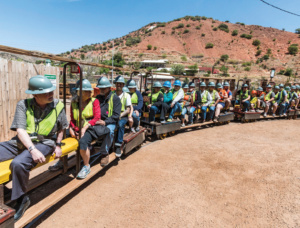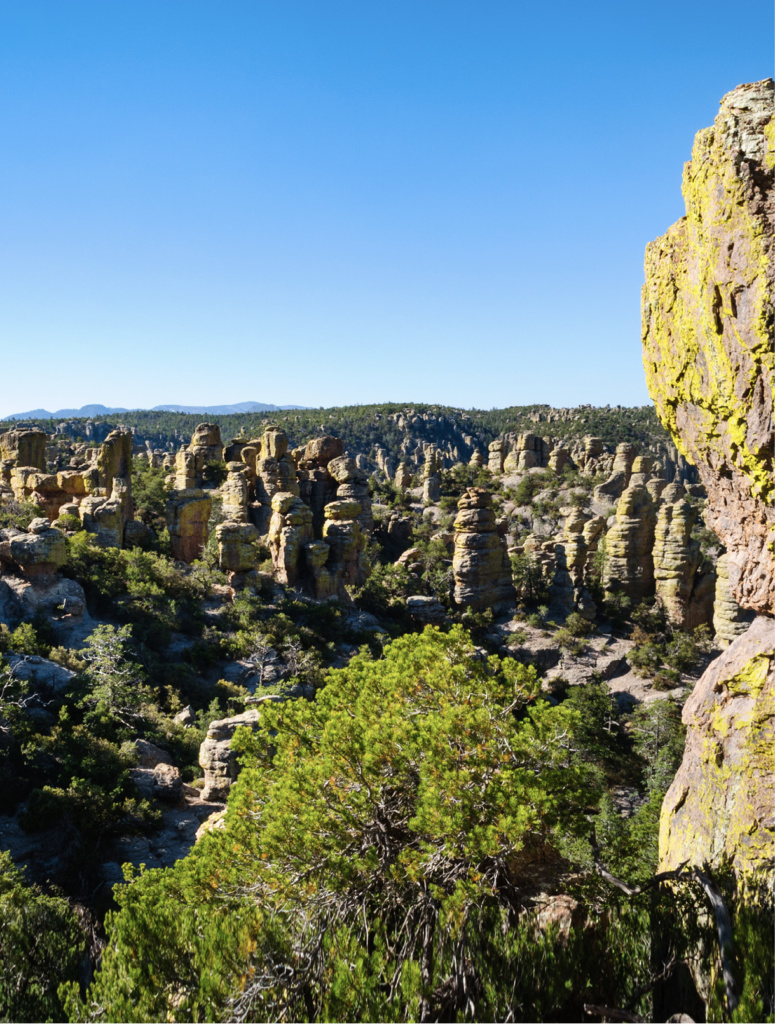 Written by Adam Sawyer
Written by Adam Sawyer
 Imagine what would happen if a village tucked into a remote Mediterranean countryside and an old American West mining town coupled up and had a baby. The offspring plopped itself down an hour and a half southeast of Tucson and a stone’s throw from the Mexican border, and became a magnet for artists, artisans, boutique shop owners and free spirits. That’s Bisbee, Arizona.
Imagine what would happen if a village tucked into a remote Mediterranean countryside and an old American West mining town coupled up and had a baby. The offspring plopped itself down an hour and a half southeast of Tucson and a stone’s throw from the Mexican border, and became a magnet for artists, artisans, boutique shop owners and free spirits. That’s Bisbee, Arizona.
As if playing a game of highway peek-a-boo, Bisbee seems to appear out of nowhere upon approach on Highway 80. The location, tucked in the hillside of the Mule Mountains, might have remained hidden away longer had early explorers in the late 1800s not taken note of the mineralized colors and striations of the mountains. They suspected massive deposits of silver, copper and zinc deep within, and they were correct. Once mining operations entered full swing, the town ballooned to a population topping 20,000, becoming the largest city between St. Louis and San Francisco.
Culture came with that influx in the form of the state’s first library, golf course and the construction of stylistically diverse, eye-catching architecture, including what still stands as the longest continually operating hotel in Arizona, The Copper Queen. There was, of course, also a section of town that catered to the preferences of the gentlemen that toiled in the mines, Brewery Gulch. It’s still there today, too, though its offerings have been cultivated.
 By the mid-1970s, mining operations had ceased, but today, visitors can soak up the town’s past at the Smithsonian-affiliated Bisbee Mining and Historical Museum, via the famous Queen Mine Tour. The experientially informative railcar tour journeys 1,500 feet into the chilly depths of the old mine.
By the mid-1970s, mining operations had ceased, but today, visitors can soak up the town’s past at the Smithsonian-affiliated Bisbee Mining and Historical Museum, via the famous Queen Mine Tour. The experientially informative railcar tour journeys 1,500 feet into the chilly depths of the old mine.
The closure of the mine meant a temporary population exodus, however, the combination of affordability, historic character and mother nature’s beautiful backdrop drew a simultaneous inundation of the aforementioned free spirits. Because of this, the town seems to occupy its own time and space, with historic Victorian buildings next to Mission Revival, Art Deco, and Craftsman structures, all set in a visually striking desert landscape of cypress, oak and cacti. On paper, none of it should go together, but in person, it does so perfectly.
Still a small town, Bisbee’s population hovers just above 5,000 residents, but the quality and quantity of things to do, see and experience plays much larger, with every store, eatery and bar possessing its own palpable vibe. For evidence, try fifth-generation Sonoran Mexican cuisine at Contessa’s Cantina, local and seasonal fare at Bisbee’s Table or casual fine dining at Café Roka. If you’re looking for a living, breathing, booze-slinging encapsulation of the whole town, head over to the Room 4 Bar within the Silver King Hotel. At 100 square feet, the former guest room is the smallest bar in the state, offering one bartender, four stools and all the charm in the world.
 Bisbee is also a wondrous place to explore on foot, through the streets and up the stairs. Indeed, much like a Mediterranean village, many of the homes perched on the cliffs above town are only accessible by stairs. As such, the staircases of Bisbee are an interconnected network that delivers pedestrians to a part of town where every step reveals eclectic neighborhoods and rocky outcrops with sweeping views of the town and the surrounding mountains. An annual fall road race, the Bisbee 1000, sends ambitious participants on a 4.5-mile sojourn that ascends more than 1,000 stairs.
Bisbee is also a wondrous place to explore on foot, through the streets and up the stairs. Indeed, much like a Mediterranean village, many of the homes perched on the cliffs above town are only accessible by stairs. As such, the staircases of Bisbee are an interconnected network that delivers pedestrians to a part of town where every step reveals eclectic neighborhoods and rocky outcrops with sweeping views of the town and the surrounding mountains. An annual fall road race, the Bisbee 1000, sends ambitious participants on a 4.5-mile sojourn that ascends more than 1,000 stairs.
Beyond Bisbee
Outside of Bisbee, there are a number of natural wonders to explore, including the forested “sky islands,” or isolated mountain ranges, of the Coronado National Forest and the desert oasis that is the San Pedro Riparian National Conservation Area, which protects part of the San Pedro River. Another highlight is Kartchner Caverns State Park, which also happens to be recognized by the International Dark Sky Association for the lack of light pollution that allows for outstanding stargazing opportunities. The park offers camping, hiking trails and wildlife viewing opportunities—all of which take a back seat to the caverns. Underground, there’s just enough well-placed lighting to be pleasantly eerie while also showcasing a number of rare subterranean formations: soda straw stalactites, massive columns, brushite moonmilk, cave bacon and turnip shields, to name a few.
 Northeast of Bisbee and not far from the border with New Mexico is the Chiricahua National Monument. The entire area was once besieged by volcanic ash and pumice that hardened into rock known as rhyolitic tuff. Then the wind, rain and several million years of erosion etched a spectacular, otherworldly landscape. There are roughly seventeen miles of hiking paths that visit all manner of hoodoos and balancing rock formations, but the Echo Canyon Loop is arguably one of the best bang-for-the-buck hikes in the state. The path meanders above an expansive valley before entering the labyrinthine grottos of Echo Canyon.
Northeast of Bisbee and not far from the border with New Mexico is the Chiricahua National Monument. The entire area was once besieged by volcanic ash and pumice that hardened into rock known as rhyolitic tuff. Then the wind, rain and several million years of erosion etched a spectacular, otherworldly landscape. There are roughly seventeen miles of hiking paths that visit all manner of hoodoos and balancing rock formations, but the Echo Canyon Loop is arguably one of the best bang-for-the-buck hikes in the state. The path meanders above an expansive valley before entering the labyrinthine grottos of Echo Canyon.
Between the caverns out west and the hoodoos to the east lies a more palate-pleasing geological wonder in the form of the Wilcox wine country. In 2016, a 526,000-acre parcel of land split between Cochise and Graham counties was designated as the Willcox American Viticultural Area (AVA). It’s an arid valley guarded by mountains on all sides, that along with high elevation and loamy soils produces some stellar Mediterranean varietals. A growing number of wineries and tasting rooms proudly produce, bottle and pour deliciously distinctive Tempranillo, Mourvedre and Viognier, among others. In fact, about 75 percent of the wine produced in Arizona can be attributed to Willcox. Bear witness by tasting the sumptuous Rhone-style reds found at the Keeling Schaefer Vineyards Tasting Room in historic downtown Willcox.
Southeast Arizona is all at once home to the state’s finest wine region, a vast landscape of astonishing geological wonders and an enchanting, heart-stealing little mountain town that is a mélange of history, natural beauty and cultural treasures—rewards for anyone willing to travel a few miles off the beaten path. 
Plan a Trip
Download the AAA Mobile app for maps, discounts, restaurants, and lodging at AAA.com/mobile. For help planning your next adventure, find a local AAA Travel Agent or call AAA Travel at 800-529-3222.


